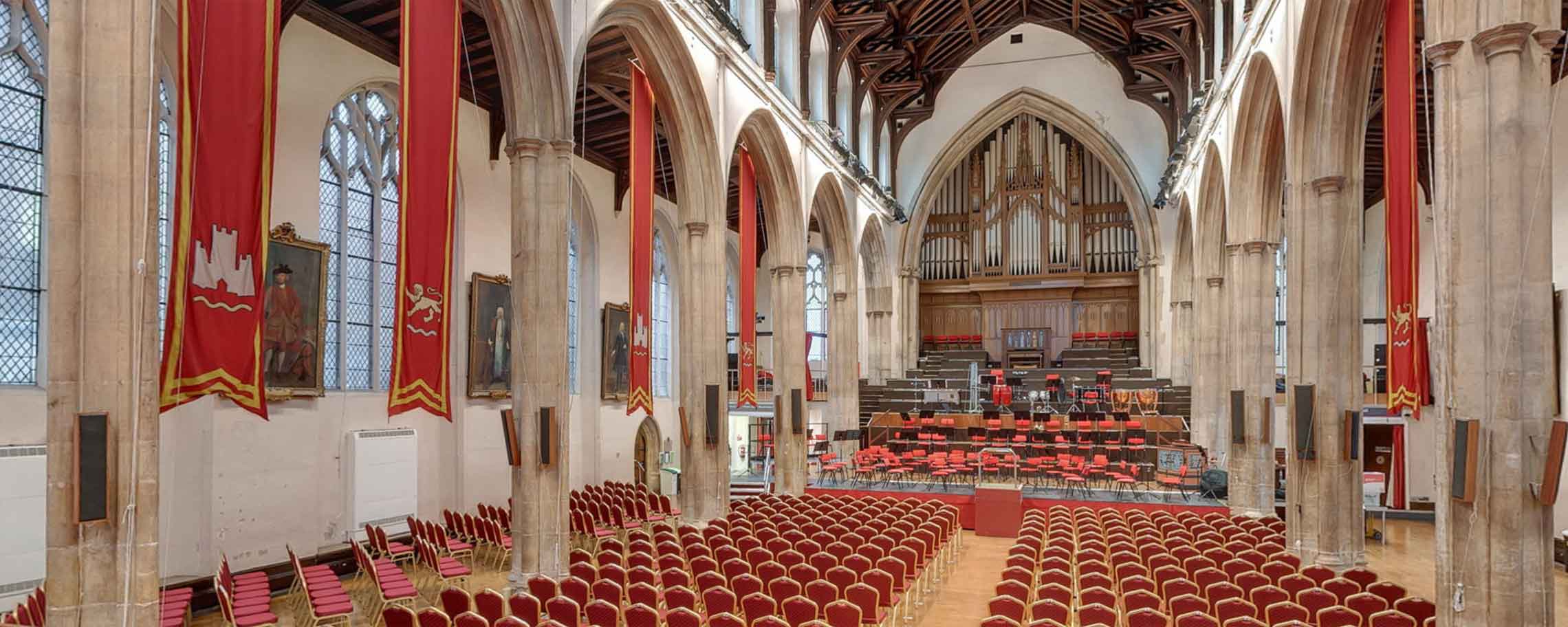St Andrew's Hall was originally the nave of the church of the Dominican friary. The chancel, now known as Blackfriars Hall, is just visible to the right of the picture.
This engraving, from Sir William Dugdale's Monasticon Anglicanum, shows the tower which subsequently collapsed during the severe gale of 1712.
The crypt dates back to the Sack Friars and survived the fire of 1413. The vaulted ceiling is an early example of the use of brick as a building material in Norwich.
Situated immediately to the north of Norwich city centre, the St Andrew's and Blackfriars' Halls, together with their crypt and cloister, are known collectively as The Halls Norwich. Grade I listed, they form the most complete medieval friary complex still surviving in England.
It was in France in 1221 that a Spanish priest, Dominic of Caleruega, later to be canonised by Pope Gregory IX, founded a religious order to be known as The Order of Friars Preachers. In the last year of his life St Dominic sent a group of his followers to England, where they set up a friary in Oxford. The friars, a mendicant order dedicated to a life of poverty, preaching and ministry to the poor, were well received, and within a few years they had established a number of religious houses throughout England.
Known also as the Dominicans, after their founder, and as the Black Friars, from the colour of their robes, the order arrived in Norwich in 1226 and were gifted as a base the old parish church of St John the Baptist in the area of Norwich known as ‘Over the Water’, just north of the River Wensum. The church no longer exists, but was probably on or close to what is now the site of the Octagon Chapel in Colegate.
In 1258 another group of friars known as the Friars Penitential, or Friars of the Sack after the coarse fabric of their habits, settled on land a short distance away just south of the Wensum, closer to the city centre and where The Halls stand today. Their presence was short-lived, however, as the Order was disbanded on the orders of Pope Clement V. The Black Friars, preferring this site to their own because of its immediate access to the river, moved here in 1307 and, with the aid of financial support from local benefactors, purchased sufficient adjoining land to build a friary and church. Construction commenced in 1326, incorporating parts of the earlier Sack Friars' buildings.
In 1413 much of the church was badly damaged by fire, and the friars moved back to their original site across the river while rebuilding took place. This was funded in part by the family of Sir Thomas Erpingham, the commander of Henry V's longbow archers at the Battle of Agincourt and whose son, Robert, was a friar at the church. The work was completed in c.1465-70 and it is this second church which survives today. The nave, now known as St Andrew's Hall was used for preaching to the public, while the chancel, now Blackfriars' Hall, was reserved for the friars' private devotions and prayers. The nave and chancel were separated by a walkway which led to the cloister on the northern side and was surmounted by an octagonal tower, which subsequently collapsed during the severe gale of 1712.
At the Dissolution of the Monasteries the friary was surrendered to the Crown, but was saved from the fate which befell many others mainly by the efforts of one man, Augustine Steward, a mercer, politician and three times mayor of Norwich, whose house still survives nearby in Tombland Alley. He successfully petitioned Henry VIII to allow the city to purchase the church for use as a municipal hall and chapel and to fund a school on the site. The transaction was completed in 1540 at a cost of £233 and in 1541 the grammar school originally founded in 1096 by Herbert de Losinga, the first bishop of Norwich, moved there, occupying a part of the cloister. The nave was converted to an assembly hall and its first recorded civic use was in 1544, when it was the venue for a feast celebrating the installation of Henry Fuller as mayor.
In 1565 thirty Dutch master weavers and their families were invited to Norwich to help with the revival of the city's ailing textile industry. They were made welcome and were soon followed by many more ‘Strangers’, as they came to be known, many of whom were Protestants eager to escape religious persecution in the Low Countries, which were still under Spanish rule. Within two decades their number had swelled to more than a third of the city's population, some 6000 out of a total of 16000. They adopted the chancel of the old friary as their church, and for a while the building was known as ‘The Dutch Church’. An annual service in Dutch was still being conducted there as recently as the 1920s.
In William III's great re-coinage of 1695-97 the cloister housed one of the five provincial mints established in conjunction with the Royal Mint in London to produce half-crowns, shillings and sixpences to replace the earlier silver coinage, of which much had been debased by clipping and some 10% was counterfeit.
From 1824 St Andrew's Hall, together with the city centre church of St Peter Mancroft, hosted a triennial classical music festival, initially conceived as a fundraising event to support the construction of the Norfolk and Norwich Hospital. Over the years the festival saw performances by many well known artistes of works by the major composers. The festival's artistic directors have included Sir Henry Wood, Sir Thomas Beecham and Sir Malcolm Sargent. It still continues today as a part of the Norfolk and Norwich Festival, now an annual event.
The Halls are home to many of the City's civic portraits of past mayors and other local dignitaries, one of the finest such collections in the country. It includes the last known portrait of Admiral Lord Nelson, painted by Sir William Beechey in 1802, just three years before Nelson's death at Trafalgar, and which hangs in Blackfriars' Hall.
Today the Halls are still owned and managed by Norwich City Council, and are available for hire for a wide variety of events which include concerts, graduation ceremonies, art exhibitions, weddings, conferences, trades fairs and a very popular annual beer festival.
For much more information about The Halls and their history please click here to visit the official website.
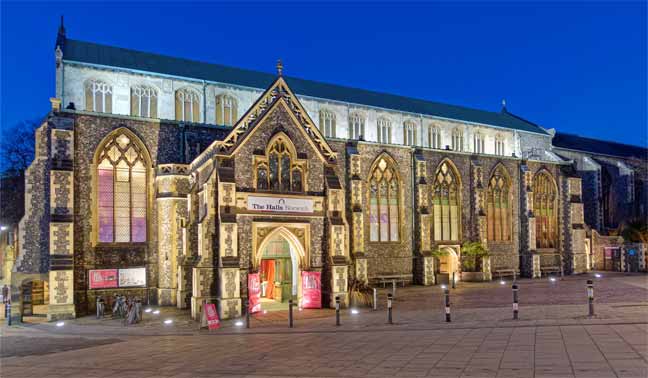
St Andrew's Hall was originally the nave of the church of the Dominican friary. The chancel, now known as Blackfriars Hall, is just visible to the right of the picture.
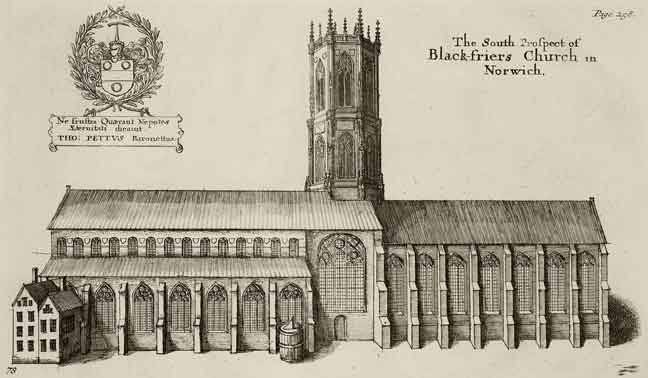
This engraving, from Sir William Dugdale's Monasticon Anglicanum, shows the tower which subsequently collapsed during the severe gale of 1712.
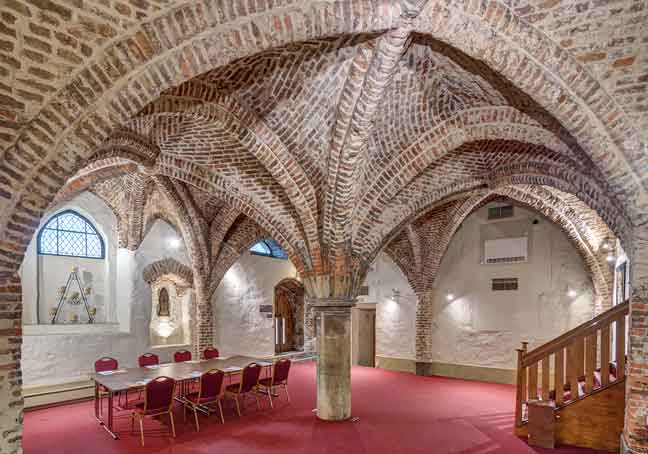
The crypt dates from 1307, having survived the fire of 1413. The impressive vaulted ceiling is an early example of the use of brick as a building material in Norwich.
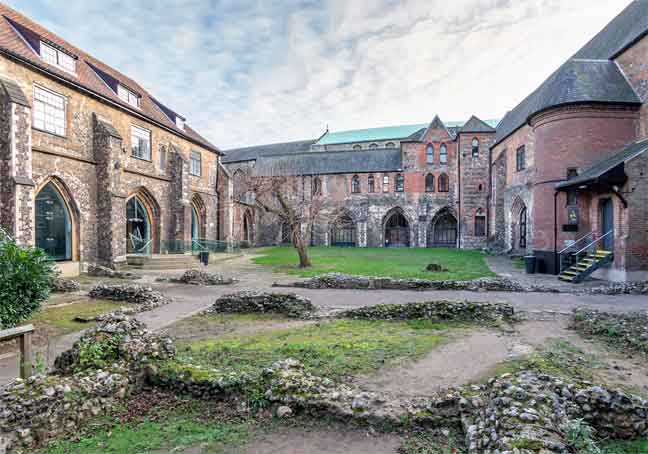
The cloister garth, looking south. The buildings to the left and right once housed the friars' dormitory and refectory, but are now used by the Norwich University of the Arts.
© 2022 Norwich360
All Rights Reserved
